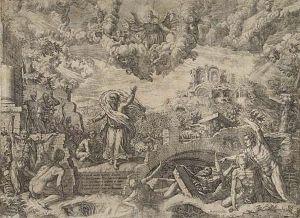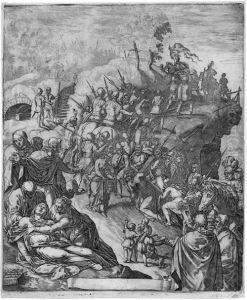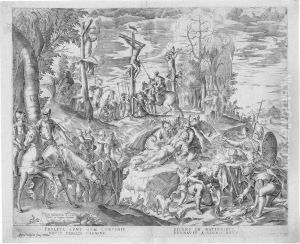Giovanni Battista Fontana Paintings
Giovanni Battista Fontana was an Italian painter and engraver of the Renaissance period, born in 1524 in the Republic of Venice. His work is often associated with the Mannerist style, which is known for its artificiality, elongated figures, and emphasis on style over substance. Fontana's contributions, however, span a variety of themes and techniques, showcasing a versatility that allowed him to navigate through the changing tastes of the period.
Fontana's early life is somewhat obscure, but it is believed that he was trained in the Venetian school, which was dominated by the influence of artists such as Titian and Tintoretto. This training is evident in Fontana's mastery of color and composition, traits that were highly regarded in Venetian art. Despite the overshadowing fame of his contemporaries, Fontana managed to carve out a niche for himself, particularly in the realm of religious and mythological subjects. His works often depicted dramatic scenes infused with a sense of motion and emotion, demonstrating his ability to engage with the viewer on a profound level.
Throughout his career, Fontana also showed a keen interest in the emerging field of printmaking. He was an accomplished engraver, and his prints circulated widely, helping to spread his reputation beyond Venice. These works were notable for their intricate details and the skillful use of light and shadow, qualities that mirrored the achievements of his paintings.
Fontana's contributions to art were not limited to his own creations. He was also involved in the intellectual art circles of his time, engaging with debates about the nature of beauty, the role of the artist, and the importance of classical antiquity as a source of inspiration. This intellectual engagement is reflected in the thematic complexity of his work, which often explored allegorical and philosophical subjects.
Giovanni Battista Fontana died in 1587, leaving behind a body of work that, while not as widely recognized as some of his peers, played a significant role in the development of Venetian art. His legacy is one of a skilled artist who managed to navigate the shifting sands of Renaissance art, adapting his style to meet the demands of his time while maintaining a distinctive voice.



